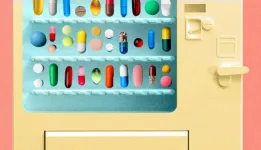Using computation to improve words: Novel tool could improve serious illness conversations
2021-07-01
(Press-News.org) Conversations between seriously ill people, their families and palliative care specialists lead to better quality-of-life. Understanding what happens during these conversations - and particularly how they vary by cultural, clinical, and situational contexts - is essential to guide healthcare communication improvement efforts. To gain true understanding, new methods to study conversations in large, inclusive, and multi-site epidemiological studies are required. A new computer model offers an automated and valid tool for such large-scale scientific analyses.
Research results on this model were published today in PLOS ONE.
Developed by a team of computer scientists, clinicians and engineers at the University of Vermont, the approach - called CODYM (COnversational DYnamics Model) analysis - uses simple behavioral state-based models (Markov Models) to capture the flow of information during different conversations, based on patterns in the lengths of alternating speaker turns.
To date, the conversation analysis process has typically relied on time-consuming manual transcription, detailed annotations, and required access to the highly private content of conversations.
"CODYMs are the first Markov Model to use speaker turn length as the fundamental unit of information and the first model of any type to provide concise, high-level, quantitative summaries of overall dependencies in sequences of speaker turn lengths," says Laurence Clarfeld, Ph.D., lead author on the study and a University of Vermont postdoctoral associate whose doctoral dissertation in computer science focused on this research topic.
Using a time-based definition of speaker turn length means that real-time automation and analysis of conversational dynamics can occur without transcription or stored audio, thus protecting the privacy of the conversation content, add the authors.
"We developed a computational model of information flow in serious illness that could become a fundamental tool in conversational epidemiology," says coauthor Robert Gramling, M.D., D.Sc., professor of family medicine, Miller Chair in Palliative Medicine, and director of the Vermont Conversation Lab at the University of Vermont's Larner College of Medicine. "It predicts important and complex conversational processes, like emotion expression and future patterns of speaker turns."
For the study, the researchers performed analyses to validate the CODYM model, "identify normative patterns of information flow in serious illness conversations and show how these patterns vary across narrative time and differ under expressions of anger, fear and sadness," the authors write.
In addition to serving as a means for assessing and training healthcare providers, CODYMs could also be used to compare "conversational dynamics across language and culture, with the prospect of identifying universal similarities and unique 'fingerprints' of information flow," the study authors state.
This publication represents the latest of several serious illness conversation dynamics studies conducted collaboratively by members of the University of Vemont's Larner College of Medicine (Gramling) and College of Engineering and Mathematical Sciences (Margaret Eppstein, Ph.D., Laurence Clarfeld, Ph.D., and Donna Rizzo, Ph.D.) over the past several years.
INFORMATION:
ELSE PRESS RELEASES FROM THIS DATE:
2021-07-01
A study by Stanford University School of Medicine investigators hints that people with COVID-19 may experience milder symptoms if certain cells of their immune systems "remember" previous encounters with seasonal coronaviruses -- the ones that cause about a quarter of the common colds kids get.
These immune cells are better equipped to mobilize quickly against SARS-CoV-2, the coronavirus responsible for COVID-19, if they've already met its gentler cousins, the scientists concluded.
The findings may help explain why some people, particularly children, seem much more resilient than others to infection by SARS-CoV-2, the coronavirus that causes COVID-19. They also might make it possible ...
2021-07-01
Scientists have developed a new technology to detect a wider variety of T cells that recognize coronaviruses, including SARS-CoV-2. The technology revealed that killer T cells capable of recognizing epitopes conserved across all coronaviruses are much more abundant in COVID-19 patients with mild disease versus those with more severe illness, suggesting a protective role for these broad-affinity T cells. The ability to distinguish T cells based on their affinities to SARS-CoV-2 could help scientists elucidate the disparity in COVID-19 outcomes and determine which COVID-19 patients will or will not exhibit a successful immune response ...
2021-07-01
In a new Editorial, Peter Heeger, Christian Larsen, and Dorry Segev discuss recent evidence - including a recent Science Immunology study by Hector Rincon-Arevalo and colleagues - that points to a diminished immune response to COVID-19 vaccines among organ transplant recipients and others on immunosuppressive drug regimens. The authors note that this presents challenges at both the individual and population levels, since current vaccine protocols may not provide adequate protection to immunosuppressed patients - who could, in turn, become reservoirs for new and dangerous variants of the virus. As such, Heeger, Larsen, and Segev argue that developing vaccination strategies for transplant recipients should be a high priority in the next wave of research focused on fighting COVID-19. ...
2021-07-01
ROCHESTER, Minn. -- Research by investigators at Mayo Clinic Cancer Center suggests that physicians should screen patients with lung cancer for MET amplification/overexpression before determining a treatment strategy. Their findings are published Cancer Discovery, a journal of the American Association for Cancer Research.
"In our research we found several lung cancer cases that were not responsive to standard chemotherapy," says Zhenkun Lou, Ph.D., a cancer researcher at Mayo Clinic. "Because these lung cancers were positive for PD-L1, a protein that allows some cells ...
2021-07-01
A key factor in America's prodigious agricultural output turns out to be something farmers can do little to control: clean air. A new Stanford-led study estimates pollution reductions between 1999 and 2019 contributed to about 20 percent of the increase in corn and soybean yield gains during that period - an amount worth about $5 billion per year.
The analysis, published this week in Environmental Research Letters, reveals that four key air pollutants are particularly damaging to crops, and accounted for an average loss of about 5 percent of corn and soybean production over the study period. The findings could help inform technology and policy changes to benefit American agriculture, and underscore the ...
2021-07-01
The number of people who live past the age of 100 has been on the rise for decades, up to nearly half a million people worldwide.
There are, however, far fewer "supercentenarians," people who live to age 110 or even longer. The oldest living person, Jeanne Calment of France, was 122 when she died in 1997; currently, the world's oldest person is 118-year-old Kane Tanaka of Japan.
Such extreme longevity, according to new research by the University of Washington, likely will continue to rise slowly by the end of this century, and estimates show that a lifespan of 125 years, or even 130 years, is possible.
"People are fascinated by the extremes of humanity, whether it's going to the moon, how fast someone can run in the Olympics, or even how long someone ...
2021-07-01
In Canada, low-income hospital patients under palliative care are less likely to receive medical assistance in dying compared to those who are high income, according to a study published in British Medical Journal Open (BMJ Open).
Medical assistance in dying (MAID) is legal and free under Medicare, Canada's universal health care system. Patients with low socioeconomic status (SES), however, generally tend to experience less access to medical care compared to their high SES counterparts.
Eldar Shafir, professor of psychology and public affairs at the Princeton School of Public and International Affairs, along ...
2021-07-01
Imaging spectroscopy can help predict water stress in wild blueberry barrens, according to a University of Maine-led study.
The technology involves measuring the light reflected off of objects depicted in images captured by drones, satellites and other remote sensing technology to classify and gather pertinent information about the objects. According to researchers, it can precisely measure light across dozens, if not hundreds, of bands of colors. The reflectance spectra can depict nutrient levels, chlorophyll content and other indicators of health for various crops, according to researchers.
Scientists from UMaine, the Schoodic Institute and Wyman's, one of the world's largest purveyors of wild blueberries and ...
2021-07-01
More than 80 percent of people around the world consider themselves to be religious or spiritual. But research on the neuroscience of spirituality and religiosity has been sparse. Previous studies have used functional neuroimaging, in which an individual undergoes a brain scan while performing a task to see what areas of the brain light up. But these correlative studies have given a spotty and often inconsistent picture of spirituality. A new study led by investigators at Brigham and Women's Hospital takes a new approach to mapping spirituality and religiosity and finds that spiritual acceptance can be localized to a specific brain circuit. This brain circuit is centered in the periaqueductal gray (PAG), a brainstem region that has been implicated ...
2021-07-01
Over the last two decades, biomaterials research has made significant progress, transitioning from traditional biomaterials to biomaterials with controlled structure and dynamic functionality. A number of building blocks have been explored for developing biomaterials by self-assembly, but SAPs have garnered special attention due to their tunability and potential use in various applications such as tissue engineering, wound healing, and vaccinations. Despite these benefits, the SAP-based approach is less explored in the intracellular context.
Fortunately, a team of scientists from the Tokyo Institute of Technology (Tokyo Tech), led by Assistant Prof. Takayuki Miki, have reported a de novo peptide, Y15, that ...
LAST 30 PRESS RELEASES:
[Press-News.org] Using computation to improve words: Novel tool could improve serious illness conversations


